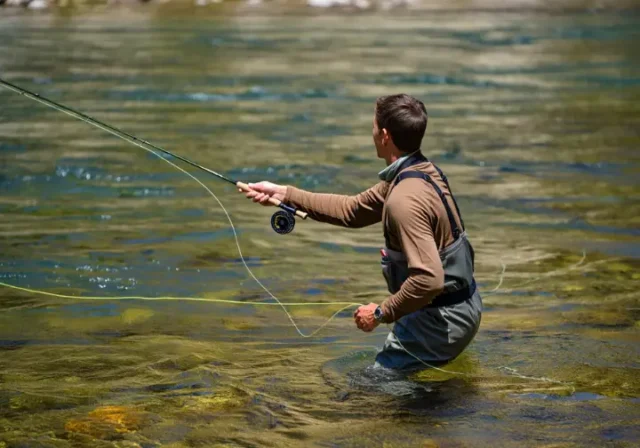In this article
When choosing waders for men, start by measuring your chest, waist, and inseam with precision to match size charts from top brands like Simms or Patagonia, ensuring a fit that won’t pinch or sag as you wade through icy currents. Opt for breathable Gore-Tex or Toray fabrics to stay dry yet cool, or neoprene for cold-water warmth. A snug fit and smart material choice keep you comfortable and leak-free. Stick around for deeper insights.
Mastering Wader Fit
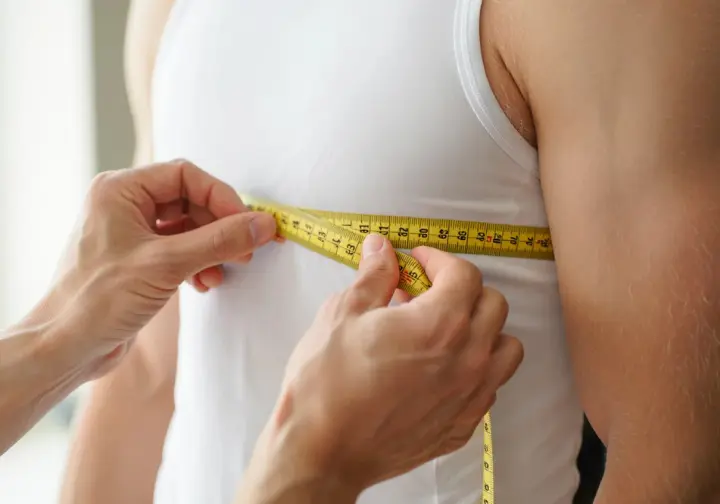
When you’re chasing that perfect catch, nailing the fit of your waders starts with accurate body measurements—grab a tape measure and jot down your chest, waist, and inseam to avoid the misery of a soggy, ill-fitting pair during a crisp dawn on the river.
Next, tackle those tricky size charts by matching your numbers to the manufacturer’s specs, ensuring you’re not stuck with waders that pinch or sag when you’re knee-deep in a rushing stream.
Believe me, I’ve seen buddies struggle with sloppy fits on opening day, and getting this right means you’ll move with confidence and stay dry for hours.
Remember, a proper fit also enhances anatomical design benefits, allowing for better mobility and comfort during long fishing sessions.
Accurate Body Measurements
Before you even think about stepping into a pair of waders, grab a tape measure and get serious about your body measurements—trust me, this is the foundation of perfecting wader fit.
Without precise numbers for chest, largest girth, inseam, and shoe size, you’re risking tight seams or sagging fabric that wears out fast. Measure your chest under the arms, keeping the tape level, and note your inseam from crotch to floor for leg comfort.
Account for thick layers in cold weather to avoid a suffocating fit. Check out this quick guide:
| Measurement | How to Take It |
|---|---|
| Chest | Under arms, across shoulder blades |
| Largest Girth | Widest part (chest/waist/hips) |
| Inseam | Crotch to floor, inside leg |
| Shoe Size | Standard street size, consider socks |
| Layering Allowance | Add room for fleece or base layers |
Don’t skimp here—accuracy means waders that feel like a second skin! Just like choosing the right fly rod weight, precise measurements ensure comfort and performance in any fishing environment.
Decoding Size Charts
As you stand ready to pick the perfect waders, decoding size charts becomes your secret weapon to nailing that second-skin fit. Don’t just glance at “Medium” or “Large”—dig into the specifics like girth, inseam, and foot size.
Brands like Simms and Patagonia define measurements differently, so compare their size charts closely to match your stats. Notice specialized fits—grab “King” for a stockier build or “Tall” for extra leg length. Check bootie ranges to avoid cramped toes, sizing up if needed.
When you can, slip into those waders, testing mobility with layers on. Sense for tightness or bagginess, tweaking with suspenders. Master these charts, and you’ll stride through rivers with confidence, every step snug and secure. Remember, just like choosing a fly fishing rod, the right fit in waders is crucial for comfort and performance on the water.
Choosing Wader Materials
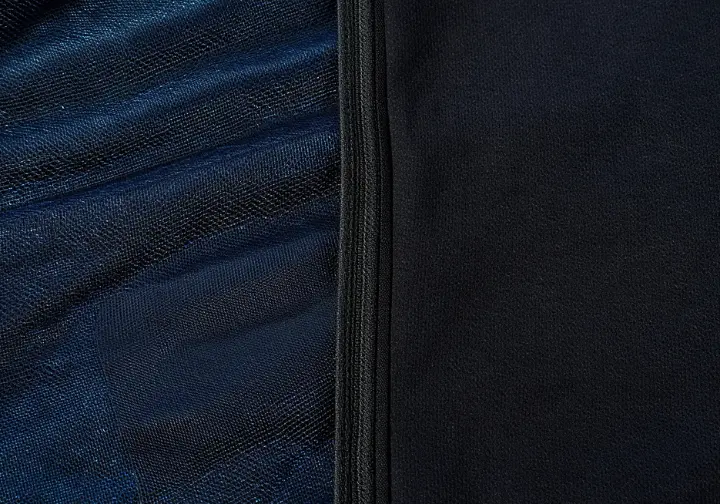
When you’re picking out waders, the material can make or break your day on the water, and breathable fabrics offer a game-changing mix of comfort and durability for those long, sweaty treks to your favorite fishing spot.
If you’ve ever felt bogged down by heavy gear, neoprene’s insulating capability is your ally, keeping you warm in icy streams, though it’s best for shorter outings because of its weight.
Take a close look at your fishing conditions—match breathable options for summer runs or neoprene for winter chills to stay dialed in and focused on the catch.
Additionally, consider layering apparel underneath waders to adapt to changing conditions for optimal comfort during unpredictable weather on the water.
Breathable Fabric Insights
While stepping into a rushing river on a crisp morning, you’ll quickly appreciate the magic of breathable waders, crafted from multi-layer fabrics with microporous membranes like Gore-Tex® or specialized coatings that block liquid water but let your perspiration escape as vapor. This breathable fabric keeps you dry without that sticky, clammy feel, even after hours of casting.
Lightweight and packable, these waders offer unmatched flexibility for hiking to remote spots. Layer up with synthetics or fleece to tackle any season, from sultry summers to frosty winters.
Choose premium options like Simms G3 with Gore-Tex® for top-tier durability, or Toray® fabrics for value. Maintain them by cleaning with technical washes and air-drying away from heat. You’ll notice the difference on every adventure. For bass fishing in these conditions, selecting the right fishing line type can significantly enhance your success rate.
Neoprene Fabric Insights
Turn your attention to neoprene waders, a forceful choice when the water turns icy and bites at your skin with every step into a frigid river at dawn. These synthetic rubber beasts, packed with gas bubbles, hug your warmth close, insulating like a wetsuit in temps below 50°F.
Pick a thickness—3.5mm for cool, 5mm for cold, or 7mm for brutal freezes—based on your waters. Sure, neoprene traps sweat, so you’ll feel clammy after a hike, and it’s bulky, slowing your stride. But for stationary fishing or hunting in numbing cold, it’s unmatched, often at a wallet-friendly price.
Rinse after use, air-dry away from sun, and store cool to keep neoprene tough against rugged snags and bitter chills. For added gear protection in harsh conditions, consider using accessories like corrosion-resistant rod holders to safeguard your fishing equipment.
Footwear & Traction Choices
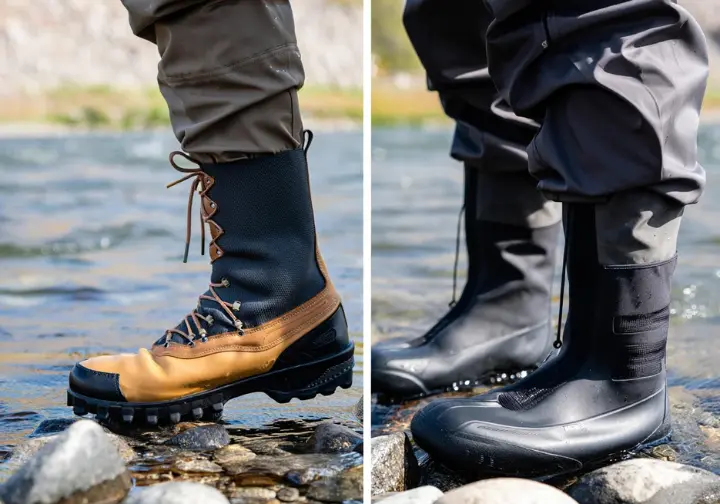
When you’re picking out waders, don’t overlook the critical choice between bootfoot and stockingfoot designs—bootfoot offers built-in boots for quick, hassle-free setup.
Whereas stockingfoot pairs with separate wading boots for a custom fit that hugs your feet like a trusted old friend.
Your traction on slick river rocks hinges on the sole type of those wading boots, with felt gripping like a bear’s paw on mossy surfaces and rubber studs biting into gravel for stability you can sense with every step.
Choose based on the terrain you’ll tackle most, whether it’s the glassy streams of Montana or the rugged boulder fields closer to home, and you’ll stand firm against any current.
If you’re fishing in diverse environments like those in Baja Mexico, consider boots that can handle both sandy flats and rocky shores for versatile traction needs.
Bootfoot vs Stockingfoot
As you gear up for your next fishing adventure, the choice between bootfoot and stockingfoot waders can shape every step you take along the water’s edge.
Bootfoot waders, with boots built right in, offer unmatched convenience—slip them on fast for surf fishing or muddy treks, keeping debris out while insulated options warm your toes in icy streams. But they’re heavier, less adjustable, so sizing up might be your best bet if the fit’s off.
Stockingfoot waders, paired with separate boots, deliver a snug, supportive fit for rocky riverbeds, plus lighter weight for long hikes. Make certain their gravel guards hook tight to shield the neoprene.
Pick bootfoot for ease, stockingfoot for precision—your waders define your stride on every cast.
For those planning a trip like fishing in Cabo during March, you’ll find that consistent sea breezes enhance trolling conditions, making the right wader choice even more critical for comfort.
Wading Boot Sole Types
While selecting the right waders sets the stage for comfort, your choice of wading boot sole can make or break your footing on a slick riverbed or muddy bank. Opt for rubber soles if you’re tackling mixed terrain; their lug patterns bite into mud and trails with Vibram®-like durability, plus they’re non-absorbent, curbing invasive species spread.
Felt soles grip algae-slick rocks underwater like glue, but they falter on land and may be banned—check local rules. For treacherous spots, add studs to your wader boots; their tungsten bite conquers icy logs, though they clatter on rocks, spooking fish.
Match your sole to your river’s challenges—rubber for versatility, felt for underwater slip, or studs for extreme grip—and tread confidently. Additionally, consider using ice cleats for enhanced traction on icy surfaces during winter fishing conditions.
Key Wader Features
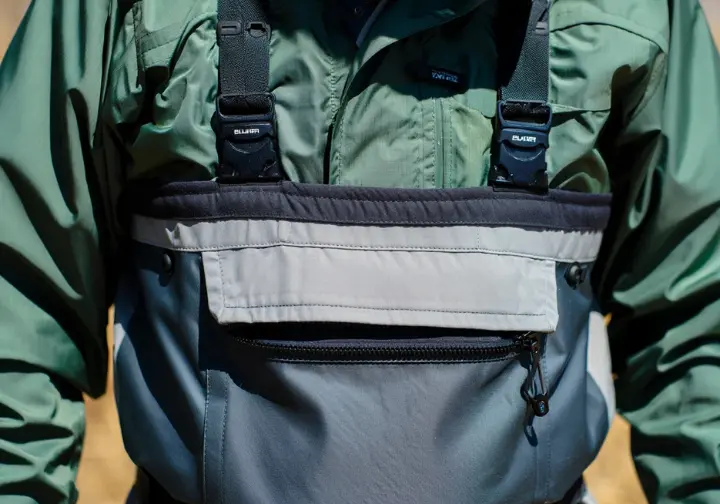
When you’re picking out waders, don’t overlook the game-changing details like pockets and storage, belts, suspenders, and guards that can make or break your day on the water.
Notice how a well-placed pocket keeps your gear within arm’s reach, whereas a sturdy belt and suspenders lock everything in place, saving you from the frustration of sagging waders during a chilly, fast-moving stream. And those built-in guards? They’re your shield against sharp rocks and hidden snags, ensuring you stay focused on landing that trophy fish instead of patching holes.
For fly fishing on rivers like the Llano, choosing waders with durable materials is crucial to handle the rough granite rock gardens and varying terrain.
Pockets and Storage
If you’ve ever fumbled for a fly box mid-stream with icy fingers, you’ll understand why pockets and storage on chest waders aren’t just a bonus—they’re a revolution.
In waders for men, a well-designed chest pocket holds your fly boxes and tools, while fleece-lined handwarmer pockets with drainage holes save your hands on frosty mornings.
Internal waterproof pockets guard phones and keys with secure zippers, and modular designs let you attach extras for customized trips. Check pocket layouts to avoid bulk hindering your cast. Here’s a quick guide to storage options:
| Pocket Type | Best For | Key Feature |
|---|---|---|
| Chest Pockets | Gear like fly boxes | Multiple compartments |
| Handwarmer Pockets | Cold hands | Fleece lining |
| Internal Pockets | Valuables | Waterproof closures |
Belts, Suspenders, Guards
Beyond the convenience of pockets, the real backbone of chest waders lies in features like belts, suspenders, and gravel guards that keep you safe and comfortable on the water.
A snug wading belt is your lifeline—if you slip, it slows water from flooding in, keeping you buoyant enough for self-rescue. Upgrade to a padded belt with back support for those long, grueling days on the river.
Suspender systems, especially padded harnesses with secure buckles, prevent shoulder strain and let you roll waders down to waist-highs with clever opposing clips for hot days.
Gravel guards, with their tight neoprene cuffs and lace hooks, block gritty debris from sneaking into your boots, saving your feet from misery during relentless wades.
Top Men’s Wader Picks
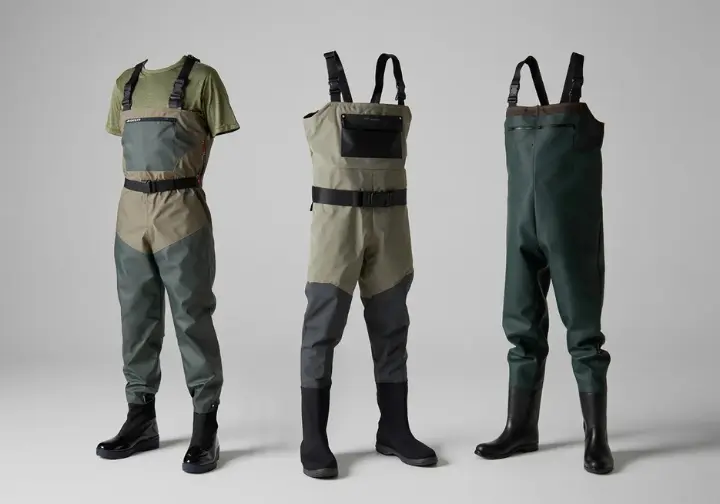
You’ve got your eye on the perfect waders, and I’m excited to share my top picks for men that’ll keep you dry and comfortable on every fishing adventure, from serene dawn casts to rugged backcountry treks.
Whether you’re hunting for the best value selections and budget-friendly options or craving lightweight travel waders for easy packing, or even tough cold weather and hunting waders to battle icy winds, I’ve tested gear that delivers real performance.
Let’s explore these standouts that’ll match your needs and make every trip seem like striking gold on the water.
Best Value Selections
When you’re hunting for waders that balance quality and cost, you can’t go wrong with the Simms Freestone Stockingfoot Waders, which boast impressive Toray fabric durability and performance that feels like a steal for the price.
Slide into the Orvis Clearwater Stockingfoot Waders next, and you’ll notice solid features with reliable performance, making them a fantastic pick for beginners or intermediate anglers looking to upgrade without breaking the bank.
Trust me, whether you’re wading through a crisp, early morning stream or battling a feisty trout, these options keep you dry and focused on the catch.
Simms Freestone Stockingfoot Waders | Excellent Toray durability/performance for the price point

If you’re a fly angler tackling varied conditions—from chilly morning streams to wet, unpredictable riverbeds—the Simms Freestone Stockingfoot Waders stand out as a top value pick with their exceptional Toray durability and performance.
That 4-layer Toray QuadraLam fabric feels light at just 38 oz, yet it’s fully waterproof with sealed seams, keeping you dry in chest-deep water. The breathable polyester wicks sweat, so you’re not stewing on long days.
Articulated knees let you stride over slick rocks effortlessly, while gravel guards fend off debris. Adjustable suspenders and a fleece-lined chest pocket add custom comfort for any frame.
Best For: Fly anglers seeking durable, breathable waders for varied conditions in rivers and streams.
PROS:
- Exceptional waterproofing with 4-layer Toray QuadraLam fabric and sealed seams for dry comfort in chest-deep water.
- Articulated knees and adjustable suspenders provide excellent mobility and a customizable fit.
- Breathable material and fleece-lined pockets enhance comfort during long, cold fishing sessions.
CONS:
- Some users report leaks around seams or stockingfeet after moderate use.
- Higher price point may not suit occasional anglers looking for budget options.
- Stockingfeet sizing can feel tight with thicker socks, limiting versatility.
Orvis Clearwater Stockingfoot Waders | Solid features, reliable performance, great beginner/intermediate option
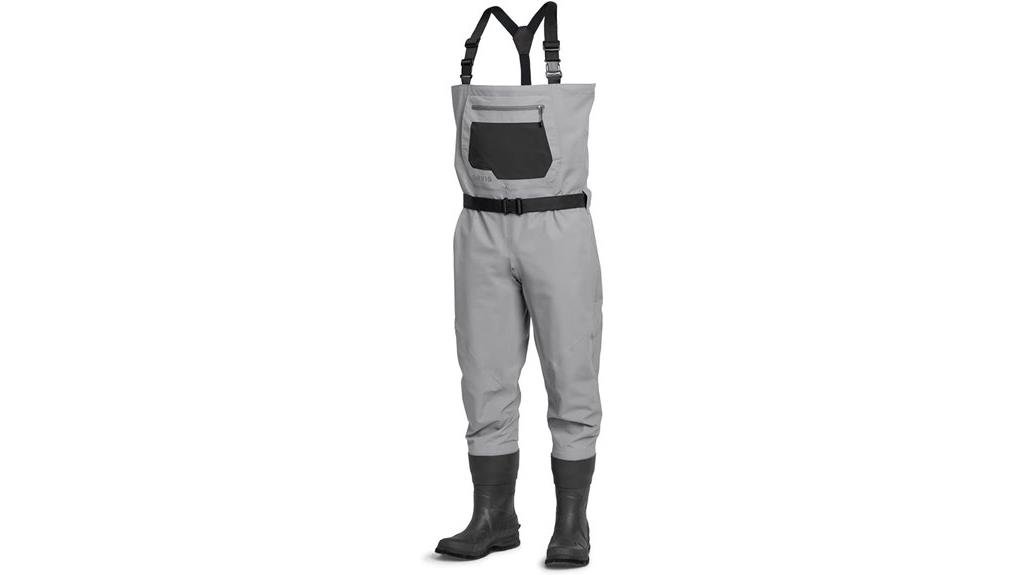
Dig into the Orvis Clearwater Stockingfoot Waders, a standout choice for beginner and intermediate fly anglers craving comfort and dependability without breaking the bank.
You’ll notice the lightweight 4-layer nylon shell—just 32 oz in medium—easing fatigue on long stream days. The 20K waterproof and 15K breathable fabric keeps you dry and cool.
While anatomical 4 mm neoprene booties with gravel guards hug your feet for stability. Zippered chest and handwarmer pockets stash essentials, and side-release buckles convert them to waist-high for hot days.
Check Orvis’ fit chart—sizing can be tricky for some. Solid performance awaits!
Best For: Beginner and intermediate fly anglers seeking a balance of comfort, mobility, and affordability in their fishing waders.
PROS:
- Lightweight 4-layer nylon shell reduces fatigue during extended fishing trips.
- Breathable fabric with a 15K rating ensures comfort in varied weather conditions.
- Anatomical neoprene booties and gravel guards provide stability and protection.
CONS:
- Some users report seam leaks after repeated use, especially at stress points.
- Booties may feel tight for those with wider feet or thicker socks.
- Pricing may seem high for a mid-range wader compared to premium alternatives.
Budget-Friendly Options
If you’re hunting for waders that won’t drain your wallet, start with the Frogg Toggs Hellbender PRO Stockingfoot Wader, a feature-packed steal that delivers decent performance regardless of some mixed reviews on durability—perfect for those chilly dawn casts when you need reliable gear without the hefty price tag.
For a simpler choice, check out the Compass 360 Deadfall Breathable STFT Wader, an affordable, breathable option that’s ideal for occasional trips, keeping you cool and dry during those sporadic summer outings on the river.
Believe me, with these picks, you’ll feel the rush of wading into your favorite fishing spot without stressing over the cost.
Frogg Toggs Hellbender PRO Stockingfoot Wader | Feature-packed for low cost, decent performance, mixed durability reviews
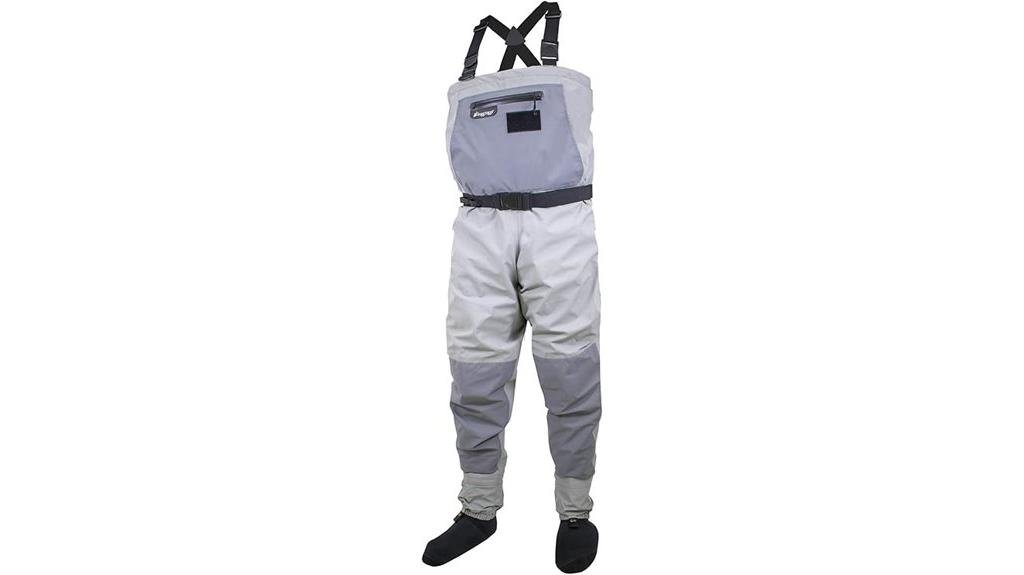
Discover the Frogg Toggs Hellbender PRO Stockingfoot Chest Wader, a standout in budget-friendly options for men who desire affordability without sacrificing functionality on their fly fishing adventures. You’ll experience the lightweight 4-ply DriPore Plus nylon upper keeping you cool during long river sessions, while the breathable fabric cuts fatigue.
With double-reinforced knees and adjustable X-back suspenders, you’re set for durability and a snug fit.
Store gear in zippered pockets, including a flip-out chest pocket, but watch for tight 4mm neoprene booties if you’ve got larger feet. Some report seam leaks, so inspect regularly for lasting performance.
Best For: Anglers seeking an affordable, lightweight chest wader for occasional fly fishing in rivers and streams.
PROS:
- Lightweight 4-ply DriPore Plus nylon upper reduces fatigue during extended use.
- Ample storage with multiple zippered pockets, including a flip-out security chest pocket.
- Adjustable X-back suspenders and wading belt provide a customizable, comfortable fit.
CONS:
- Recurring reports of seam leaks, especially after minimal use, affecting waterproof reliability.
- Tight 4mm neoprene booties may be uncomfortable or incompatible with larger feet or thicker socks.
- Fabric at double-reinforced knees can wear out quickly under heavy or rough use.
Compass 360 Deadfall Breathable STFT Wader | Basic, affordable breathable option for occasional use
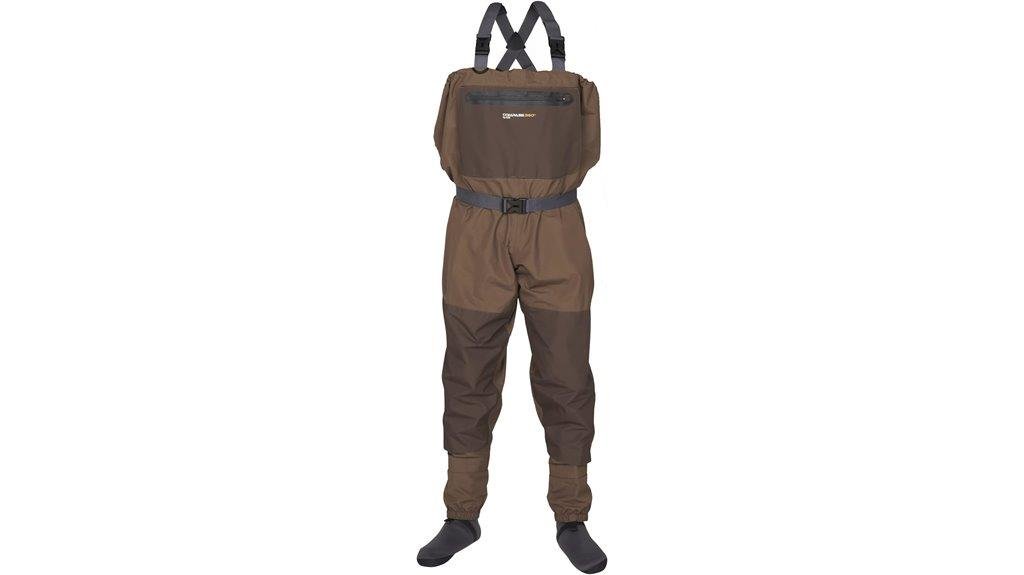
Grab a spot on the riverbank with the Compass 360 Deadfall Breathable Stockingfoot Chest Wader, a standout choice if you’re an occasional fly fisher seeking a budget-friendly option that doesn’t skimp on essential features.
Sense the lightweight 4-layer polyester fabric—breathable and DWR-coated—keeping you cool during long stream sessions. You’ll appreciate the double-reinforced knees and shins as you navigate rocky terrain, plus the fleece-lined handwarmer pockets for chilly mornings.
Adjust the suspenders for a snug fit, stash gear in the zippered chest pocket, and note the 4mm chloroprene booties. Just watch sizing—some find them tight with thicker socks.
Best For: Occasional fly fishers looking for an affordable, breathable wader with essential durability and comfort features.
PROS:
- Lightweight and breathable 4-layer fabric keeps you cool and comfortable during long fishing sessions.
- Double-reinforced knees and shins provide extra protection in rough, rocky terrain.
- Budget-friendly price point offers great value for the features included.
CONS:
- Some users report leaks at seams or booties after extended use.
- Booties may run small, causing discomfort with thicker socks or larger feet.
- Chest pocket is not fully waterproof, risking wet belongings.
Lightweight & Travel Waders
When you’re chasing fish in remote streams or hopping a quick flight for a weekend getaway, lightweight and travel-friendly waders become your best ally. The Redington Sonic-Pro Ultra Packable Wader stands out as a top pick.
You’ll notice the difference with its minimal weight, barely recognizing it in your pack as you trek through rugged terrain. Its compact design slips easily into a duffel for those spontaneous trips.
Trust me, after a long day casting on a hidden river, you’ll appreciate how this wader cuts the bulk without sacrificing durability for your next adventure.
Redington Sonic-Pro Ultra Packable Wader | Designed for minimal weight and pack size
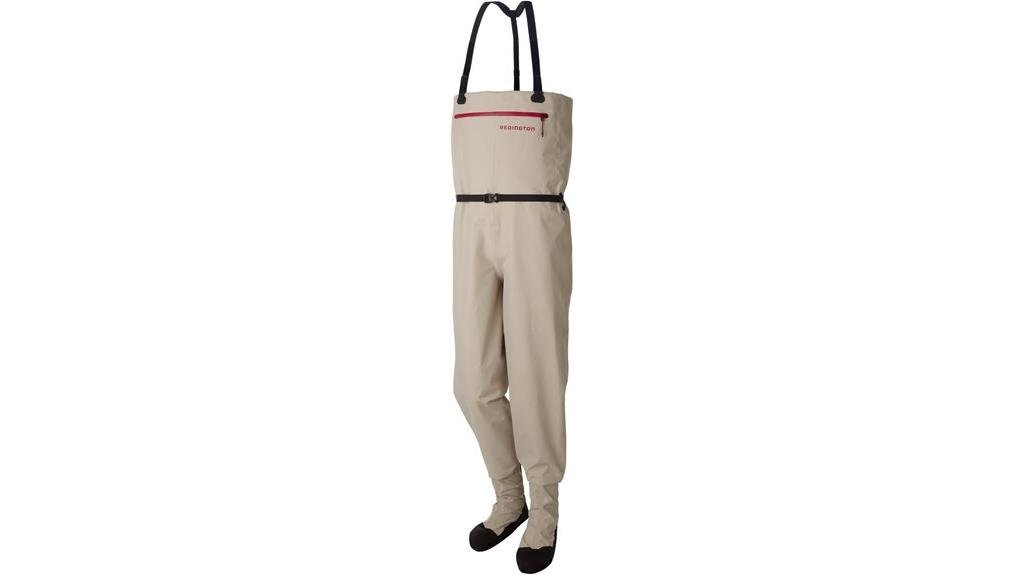
If you’re a fly angler chasing remote streams or planning a destination trip, the Redington Sonic-Pro Ultra Packable Wader is your go-to gear for its featherlight design and travel-ready build.
Weighing just 30.4 oz in size large, this 4-layer nylon wader packs into its front pocket, earning kudos from Fly Rod and Reel magazine.
Experience the freedom of its breathable, DWR-coated fabric and SonicWeld seams as you trek to hidden waters.
The front zipper and detachable tool pack make changes and storage a breeze.
Note, though—booties can run snug, and seams might leak after heavy use.
Best For: Anglers seeking a lightweight, packable wader for fly fishing in remote locations or during travel.
PROS:
- Extremely lightweight at 30.4 oz, perfect for backpacking and destination trips.
- Highly breathable fabric ensures comfort in warm weather conditions.
- Innovative packable design with a front pocket for easy storage and transport.
CONS:
- Booties may fit snugly, causing discomfort with thicker socks.
- Some users report seam leaks after extended or heavy use.
- Thinner material may not hold up in rugged, heavy-duty environments.
Cold Weather & Hunting Waders
When the chill of late fall bites at your skin and you’re stalking game through icy marshes, you’ll need waders built for cold weather and hunting, like the Frogg Toggs Amphib Neoprene Bootfoot Wader with its affordable neoprene insulation to keep you warm in frigid water.
For a rugged option customized to hunters, check out the Gator Waders Shield Series Insulated Waders, crafted with durable materials, solid insulation, and camo patterns that help you blend into the frosty environment.
Believe me, slipping into these on a frosty dawn feels like gearing up for victory—pick the pair that matches your terrain and stay comfortable while you outlast the cold.
Frogg Toggs Amphib Neoprene Bootfoot Wader | Affordable neoprene insulation for cold water/weather

Plunge straight into the heart of cold-weather fishing with the Frogg Toggs Amphib Neoprene Bootfoot Chest Wader, a standout choice for men braving icy waters and harsh conditions during fishing or hunting trips. Experience the chill fade as the 3.5 mm neoprene and 200-gram Thinsulate boots wrap you in warmth, even in single-digit temps.
Wade chest-deep with confidence thanks to the high-back design and triple-stitched, waterproof seams. Adjust the neoprene suspenders for a snug fit, layer up with ease, and stash gear in handwarmer pockets.
Though boots can feel bulky, reinforced knees and affordability make this a solid pick.
Best For: Anglers and hunters seeking affordable, insulated waders for cold-weather fishing or hunting in deep, icy waters.
PROS:
- Provides excellent warmth with 3.5 mm neoprene and 200-gram Thinsulate boots, even in single-digit temperatures.
- High-back design and adjustable suspenders ensure a secure fit for chest-deep wading.
- Offers good value for the price with reinforced knees and handy handwarmer pockets.
CONS:
- Boots can feel bulky, potentially hindering mobility on uneven terrain.
- Some users report leaks in boots or seams after minimal use.
- Sizing issues, especially with boot fit and leg length, may affect comfort for shorter individuals.
Gator Waders Shield Series Insulated Waders | Hunting specific, durable materials, insulation, camo patterns available

Crafted for the relentless waterfowl hunter or cold-weather angler, the Gator Waders Shield Series Insulated Waders in Mossy Oak Bottomland stand out as your go-to gear when facing frigid marshes or icy streams. Feel the chill fade with 1600g Thinsulate boots and quilted thermal lining, keeping you toasty in sub-freezing hunts.
You’ll stride confidently with aggressive treads and reinforced 900D rear seats resisting rugged terrain. Stash shells in six holders and warm hands in fleece-lined pockets.
Though some report seam leaks or tight boots after a season, most praise the roomy, durable fit for all-day wear.
Best For: Waterfowl hunters and cold-weather anglers seeking durable, insulated waders for frigid conditions.
PROS:
- Exceptional warmth with 1600g Thinsulate boots and quilted thermal lining for sub-freezing environments.
- Durable design with 900D reinforced rear seat and leg gaiters to withstand rugged terrain.
- Convenient features like six shotgun shell holders and fleece-lined handwarmer pockets for enhanced usability.
CONS:
- Some users report seam leaks after one or two seasons of use.
- Boot sizing can be inconsistent, leading to discomfort for certain individuals.
- Higher price point may not justify occasional quality concerns for some buyers.
Caring For Your Waders
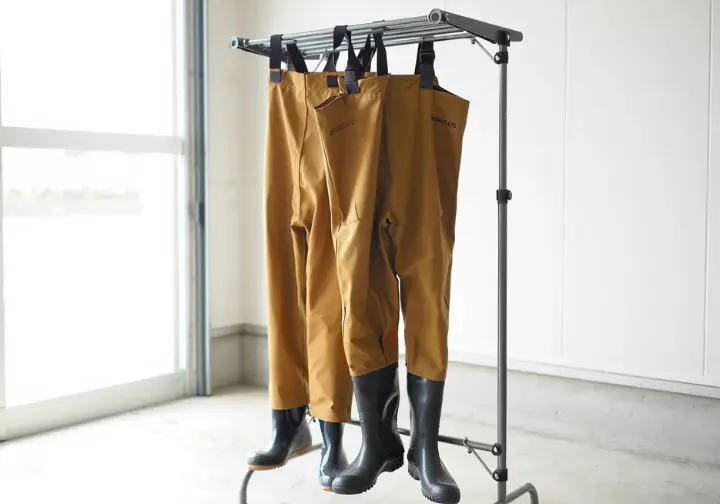
You’ve invested in a solid pair of waders, so let’s keep them in top shape with proper care that extends their life through countless river runs. Start by mastering the cleaning and drying steps—rinse off mud and grit after each trip with fresh water.
Then hang them upside down in a cool, shaded spot to avoid that stale, damp smell lingering from your last dawn on the water. Once they’re dry, store them rolled or loosely folded in a dry place.
Always check for small tears or leaks to patch up quick with a repair kit, ensuring you’re never caught off-guard mid-stream.
Cleaning and Drying Steps
After a long day battling the current and hauling in that trophy catch, your waders have taken a beating from mud, saltwater, and grit—so let’s make certain they’re ready for your next adventure.
Start by rinsing them with fresh water after every trip, especially post-saltwater, to wash away corrosive gunk that cakes zippers and boot seams.
Occasionally, hand wash inside and out with cold water and a gentle tech wash like Revivex, dodging harsh detergents that wreck membranes.
Drying’s the real game-changer—hang ‘em inside-out in a breezy spot, no direct sun or heat, until bone-dry, then flip ‘em right-side-out.
Skip machine dryers; heat ruins fabric.
Clean zippers of grit and lube ‘em up for smooth action.
Storage and Repair Basics
While your waders are built to withstand rugged rivers and relentless weather, they’ll only last if you store ‘em right and patch up the inevitable wear and tear. Hang ‘em by the boots on a specialized wader hanger in a cool, dry, dark spot—away from scorching attics or freezing garages that degrade material. Don’t fold ‘em tight; creases weaken fabric and invite leaks.
If hanging’s not an option, lay ‘em flat or roll loosely, far from sharp objects or oily messes.
For repairs, flip breathable waders inside out, spray isopropyl alcohol to spot pinholes as dark patches, mark ‘em, and seal with Aquaseal FD—let it cure 8-12 hours.
For neoprene, use specialized cement, press tears tight, and patch inside for durability.
Final Wader Wisdom
As you stand on the riverbank, the morning mist curling over the water, picking the right waders becomes your shield against the chill and your ticket to endless fishing adventures.
You’ve gotta nail the fit—measure precisely and check brand size charts for specialized options ensuring mobility.
Choose breathable fabrics for changing temps or neoprene for icy streams.
Match stockingfoot or bootfoot styles, plus rubber, felt, or studded soles, to your terrain—check local felt rules too.
Care matters their lifelinee
Popular Questions
Are Waders Suitable for All Weather Conditions? >
How Do Waders Impact Mobility on Land? >
Can Waders Be Used for Other Activities? >
What Safety Precautions Should I Take With Waders? >
How Do Waders Affect Body Temperature? >
We are a participant in the Amazon Services LLC Associates Program, an affiliate advertising program designed to provide a means for sites to earn advertising fees by advertising and linking to Amazon.com. As an Amazon Associate I earn from qualifying purchases. We also participate in other affiliate programs. The information provided on this website is provided for entertainment purposes only. We make no representations or warranties of any kind, expressed or implied, about the completeness, accuracy, adequacy, legality, usefulness, reliability, suitability, or availability of the information, or about anything else. Any reliance you place on the information is therefore strictly at your own risk. Additional terms are found in the terms of service.


